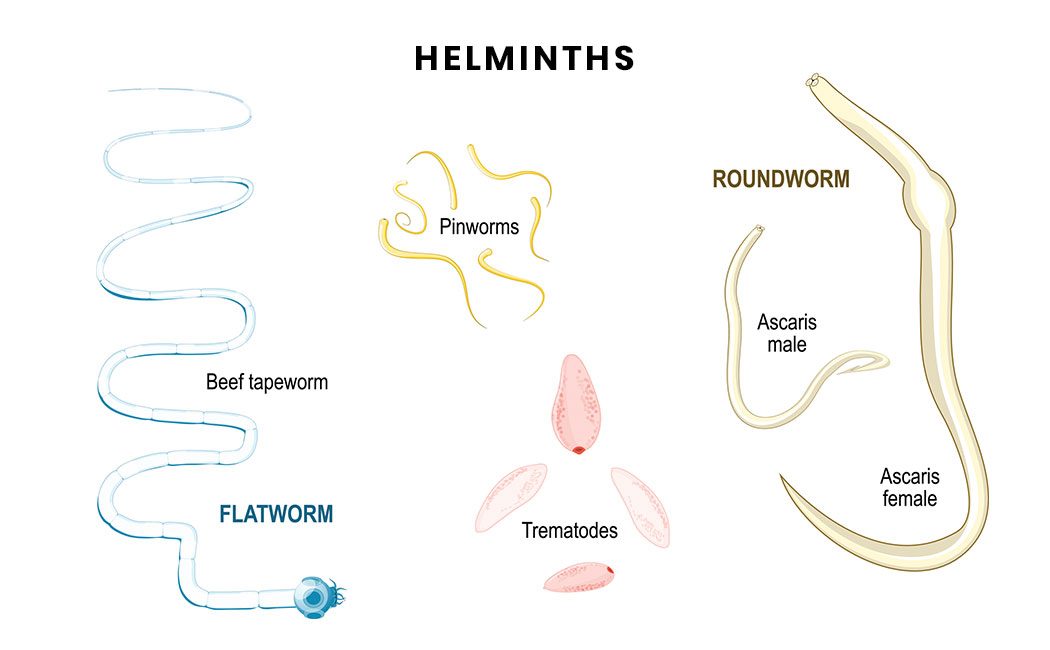Has that got your attention?
It has been found that up to 45% of the Lyme infection is carried in parasites. They live breathe and excrete inside us, they also carry their own infections of bacteria and viruses. The affiliated links between parasites and Borrelia Burgdorferi are well documented as is the impact on the immune system and the side effects these unwanted lodgers have on the human body.
So, What is a Parasite?
The very word parasite should send shivers up our spines, it means; ‘An organism that lives in or on an organism of another species (its host) and benefits by deriving nutrients at the other’s expense.’
There are three main classes or types of parasites that can cause disease in humans:
- Protozoa
- Helminths
- Ectoparasites
Each class of parasite has different groups or species of parasites. It’s Protozoa and Helminths that we are going to concentrate on in this post. And we will start with Protozoa.
Protozoa
Protozoa are microscopic, one-celled organisms that can be free-living which means they don’t need a host. Or they are also parasitic in nature, meaning they live on or in a host. They multiply in the human body; this aids their survival and allows serious infections to develop from just one single celled organism. Contaminated foods or person to person contact are one of the routes of transmission by protozoa, and they mainly live in the intestines. Protozoa that live in the blood or tissue of humans are transmitted to other humans by an arthropod vector, for example, through the bite of a tick, mosquito or sand fly.
Protozoa are a very varied group of single-celled organisms, with more than 50,000 different types represented. The vast majority are microscopic, many measuring less than 1/200 mm, but some, such as the freshwater Spirostomum, may reach 0.17 in (3 mm) in length, large enough to enable it to be seen with the naked eye. Protozoa are found in almost every possible habitat. Mainly found in developing or 3rd world countries.
Protozoa is a class of parasite that has a species e.g. Amoebozoa which has a family of Plasmodium, Entamoeba (which can cause malaria) or Giardia lamblia (giardiasis). Understand, no neither did I at first.
Protozoa are divided into four major groups;
- Amoeboid protozoans or sarcodines. Jelly-like protozoa found in fresh or sea water and in moist soil. Common symptoms of amoebic dysentery are violent diarrhea, blood and mucus in stools, dehydration, severe abdominal cramps, Anemia, fever, and chills. E. histolytica cysts can travel to the liver and cause pain, jaundice, weight loss and swelling of the liver.
- Flagellated protozoans or Zooflagellates. Most Zooflagellates live in freshwater and some inside of organisms. They cause diseases in humans, such as the African sleeping sickness.
- Ciliated protozoans or Ciliates. Ciliates can be found in just about any given environment. Balantidium coli is from pigs. Symptoms include diarrhoea, nausea, vomiting and anorexia.
- Sporozoans is basically Malaria.
One of the worst experiences we had were parasitic cysts. It was like looking down the toilet at Jurassic Park! Protozoa have two-phase life cycles, alternating between proliferative stages (increase in numbers) and dormant cysts. As cysts, protozoa can survive harsh conditions, such as exposure to extreme temperatures or harmful chemicals, or long periods without access to nutrients, water, or oxygen for periods of time. And if you’re wondering why you have aching muscles in your neck or feel full body weakness, it could be parasitic encysted larvae. They can live in our muscle fibre, they hijack the cell and hide in it like a cave.
This is called a ‘Nurse Cell’ the Larvae lie “coiled” up in these “nurse cells”. Respiratory and muscles are most heavily affected.
Are you scared yet? I was.
Helminths
Parasitic worms, also known as helminths, are large macroparasites, which as adults can generally be seen with the naked eye. Many are intestinal worms that are soil-transmitted and infect the digestive tract and gastrointestinal tract.
Helminths are large, multicellular organisms that are also visible to the naked eye in their adult stages. helminths can be either free-living or parasitic in nature. There are three main groups of helminths that are human parasites:
- Flatworms (platyhelminthes) – these include the trematodes (flukes) and cestodes (tapeworms). Platyhelminthes very commonly known as flatworms or tapeworms; these animals are soft-bodied invertebrate animals. There are around 20,000 species of these animals. A few of these live as parasites on humans and other animals.
Symptoms: nausea, lack of appetite, diarrhea, abdominal pain, weight loss, general weakness.
- Acanthocephala (acanthocephalans) These worms reside in the gastrointestinal tract. The acanthocephala are thorny-headed worms, or spiny-headed worms. Armed with spines, which it uses to pierce and hold the gut wall of its host.
Symptoms: giddiness, acute abdominal pain, tinnitus, Edema, constipation, diarrhea, undernutrition, and underdevelopment.
- Roundworms (nematodes) can live in the gastrointestinal tract, blood, lymphatic system or subcutaneous tissues. Alternatively, the immature (larval) states can cause disease through their infection of various body tissues. Some consider the helminths to also include the segmented worms (annelids).
Symptoms: abdominal discomfort, nausea, vomiting, weight loss, fever, and diarrhea.
